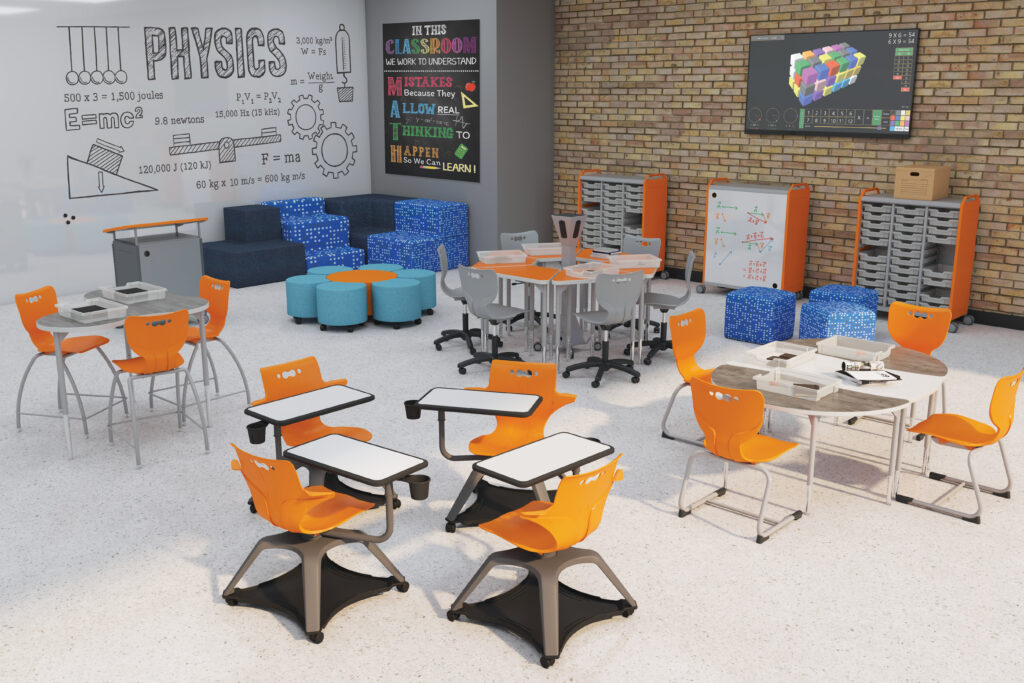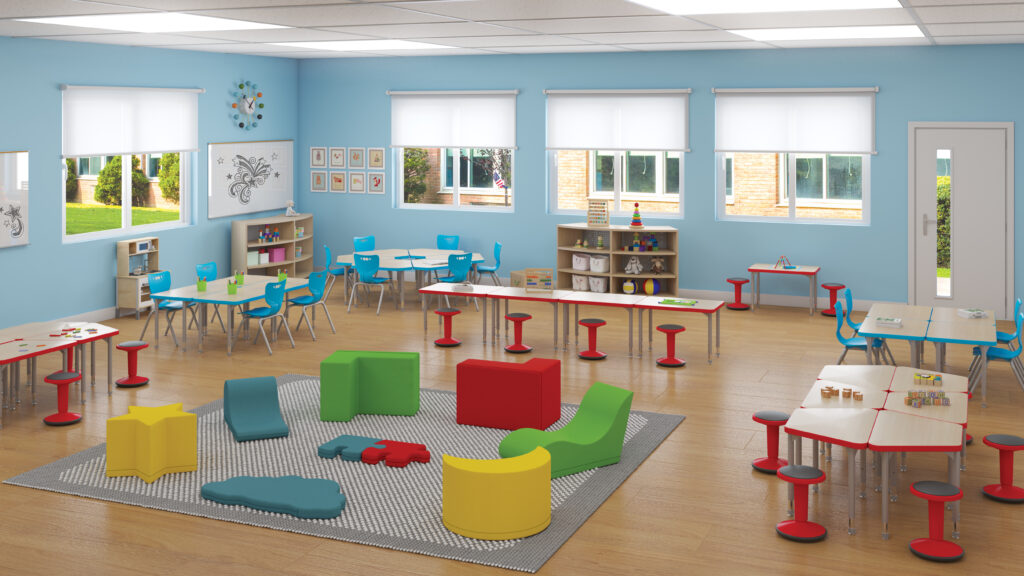When it comes to learning environment design, we already know that one size does not fit all. To accommodate the many needs of users, flexible furniture has been the industry-wide solution. Over the years, a wealth of information on the importance of student-centered design has been at the core of 21st century learning. Flexibility enables students to take ownership over how they learn best. However, the key question arises: are we making the right choices in our pursuit of flexibility? Flexibility in furniture isn’t just about offering options; it’s about offering the right options.
At MooreCo, our commitment to student-centered design has led us to collaborate with experts across various fields, including neuroscience, psychology, physical therapy, and social-emotional development. Through these collaborations, we’ve embarked on a journey called Thrive, to redefine the paradigm of furniture on learning spaces.

Dr. Lisa Harris and Dr. Amy Rohsner, from Healthworks Ergonomics, helped our team analyze both the physiological aspect of furniture design as well as the sensory response to it. There is a profound link between posture, breathing, and blood circulation to emotional well-being, anxiety, and stress. Understanding learners’ vestibular system is key. How students respond, engage, or withdrawal from stimuli deeply affects their cognitive development, concentration, self-esteem, and sense of inclusion. Drawing from Dunn’s Model of sensory preferences, Dr. Harris & Dr. Rohsner categorize students’ sensory response to the environment into four groups:
There is a profound link between posture, breathing, and blood circulation to emotional well-being, anxiety, and stress.
1. Seekers are more engaged in sensory learning, seek stimulation, and easily grow bored. Standing desks offer an outlet for their excess energy. The pneumatic, height-adjustable swiveling wobble stool provides ideal support, promoting proper posture and stimulating core muscles for improved circulation and focus. The swiveling motion soothes seekers and enhances alertness akin to a fidget spinner for the body and mind. However, fixed-height wobble stools, common in classrooms, pose issues for taller students, potentially leading to posture problems and overstimulation. Products like tablet chairs should be avoided as they can turn into distractions for seekers, encouraging inappropriate use. Creating a sensory-rich environment with suitable furniture ensures seekers remain engaged and focused, maximizing their learning potential while minimizing disruptions for others.
2. Bystanders are passive, miss sensory cues, and don’t need a lot of physical action. Misunderstood as disconnected and clumsy, they are typically comfortable in any environment. Most events of daily life are not intense enough to stimulate deep processing for bystanders. So how do we engage bystanders? Bystanders typically need to be motivated to move. Tablet chairs are ideal, as it invites full body motion to participate and connect with others. Sit-to-stand desks, or bar height tables and stools work well too. Other support tools to offer bystanders are tabletop earth magnets and dry erase table tops for writing and doodling to keep hands busy as a way of self-generating stimuli. Easy to configure desks will make bystanders engage with others without disrupting the learning environment. Products to avoid with bystanders include traditional 4-leg chairs and a singular student desk setup.
3. Avoiders are more likely to retreat from unfamiliar or overstimulating situations. They prefer sitting away from others as much as possible. These students thrived during Covid with online learning. They had the comfort of their trusted space, and no distractions or anxiety caused by others. Avoiders remove themselves from surrounding stimuli. Rocking chairs, unlike swivel stools, provide back support and the gentle rocking offers a soothing, steady full-body motion. Soft seating pieces with or without motion create community setups that help avoiders engage with others. Tables vs desks? Tables are better because they only allow enough space for small group engagement rather than large, full class interactions.
4. Sensitives are highly aware of their environment, perceiving it in ways others don’t. Every sound, every smell, every light; they are detecting more sensory input than others and it all affects how they respond. Without the right tools, sensitives withdraw and become rigid and uncooperative. Because sensitives react very quickly to stimulus, rhythm and repetition can engage them. Soft seating pieces with motion and textured fabrics that can be touched and stroked help calm this easily stimulated mind. High back seats and pods shield sound and light while allowing the student to be present and participate with their peers.

Dr. Jessica Church-Lang, UT Austin’s Developmental Cognitive Neuroscience Lab Principal Investigator, employs brain imaging to explore children’s control development. She examines how this system aids task completion, impulse inhibition, and transition from childhood to adulthood. Dr. Church-Lang identifies four pivotal tasks for cognitive growth: independence, peer relationships, identity formation, and maturity. “We are really interested in how control interacts with academic success, because the environmental context of those interactions really matters, which is why classroom design is so important,” Dr. Church-Lang mentioned. “We analyze student feedback on how furniture soothes or stimulates them. This offers great insight into their physiological needs,” she added when collaborating with MooreCo’s R + D team.
When considering the physiological aspects of learning environments, selecting age-appropriate, inclusive furnishings that promote proper posture, circulation, and breathing is essential. Dr. Chris Fagundes, Associate Professor of Psychology at Rice University underscores the importance of recognizing ergonomic needs: “There’s a lack of recognition around ergonomics, we make kids use the same desks and chairs when they’re 11 as they do when they’re 18”. According to Dr. Harris, “Poor posture not only affects the tissue of the spine and neck, but also causes shallow breathing and increased cortisol levels which triggers anxiety”. Proper slow-paced breathing is proven to relax and calm students down.

Additional factors to consider, are the impact of glare and lighting on cognitive performance. While replacing lighting fixtures may not always be feasible, leveraging furniture can offer a solution. Materials such as porcelain steel are effective in mitigating glare over HPL. Additionally, furniture choices can aid in tackling acoustic challenges on a smaller scale. Incorporating pods and acoustic dividers throughout the environment contributes to sound reduction. Prioritizing easy-to-clean and antimicrobial finishes ensures hygienic spaces.
Creating flexible learning environments entails tailoring setups to individual student needs, fostering collaboration, and prioritizing well-being. This involves versatile desks, chairs, and support tools that cater to both small and large group settings. Equipping teachers with agile tools ensures their accessibility and readiness, including technology integration and ample storage. Display walls serve as dynamic platforms for showcasing student work and facilitating collaborative projects. Above all, making the classroom an inclusive environment where physical and sensory needs are not a limitation to inspiration and collaboration is essential. As Dr. Church-Lang articulates it: “I urge you to think about students as active participants in the process of learning and to include them in decision making around the design. They love peer interaction, flexibility in design, and ability for things to be different, depending on their mood. The MooreCo designs are very flexible, adaptable, and are really fabulous examples of this.”

